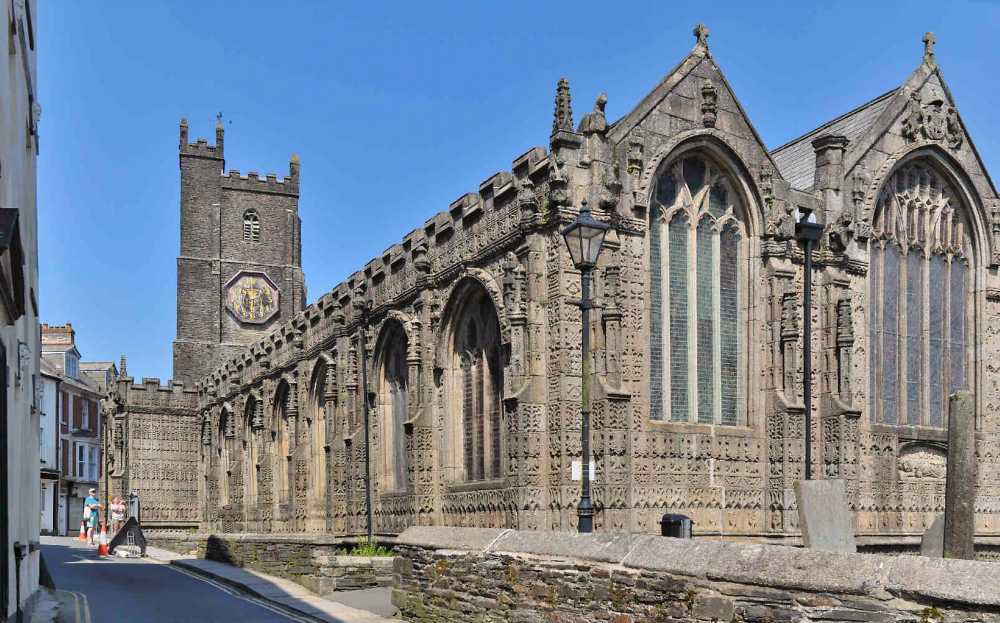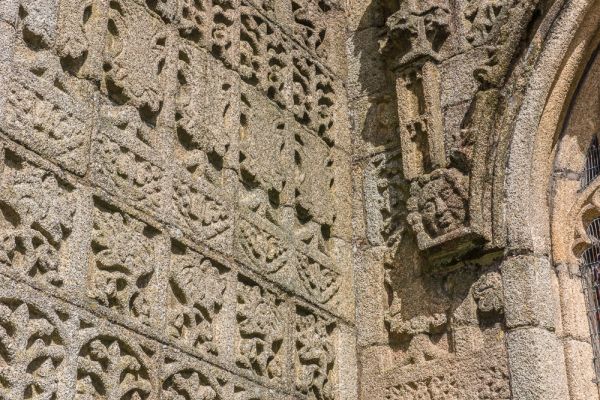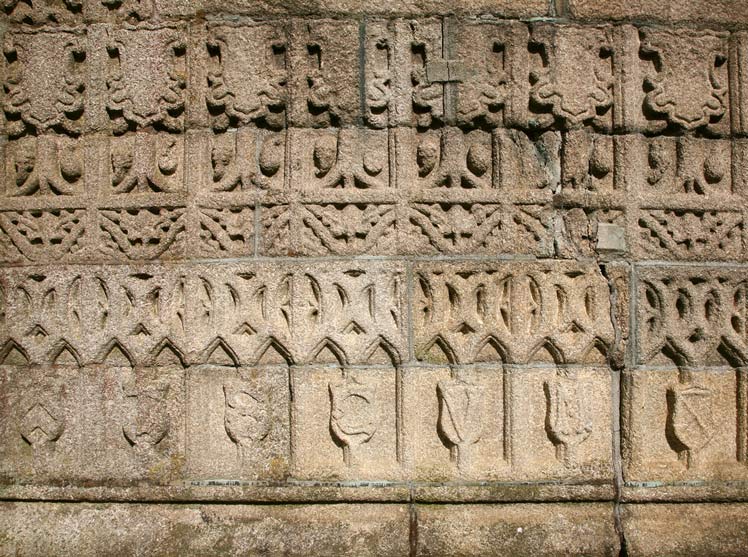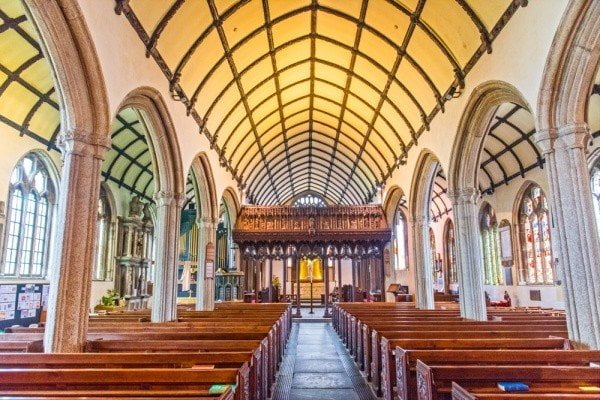The unique feature of the Church of St. Mary Magdalene, Launceston, is that it is completely encased in sculptured granite.
As we saw last time it was through the tragic death of the son and heir of Sir Henry Trecarrell that the church came to be built in the years 1511 to 1524. Rob Tremain aged 10, outside the porch of St. Mary Magdalene.
The stonework is the main feature of the church. Commencing with the south porch, we find two lines of carving immediately below the embattled parapet representing the spiked flower and fruit heads of the nardus and pomegranate plants, from which it is said the precious spikenard ointment was made with which Mary Magdalene anointed the feet of Our Lord. The canopied niche in the centre above the porch door holds the figure of St. Mary Magdalene.

This was given to the church in 1911 by the Ching family. On the base of this niche is a shield bearing the Trecarrell and Kelway arms. The coat of arms appears many times throughout the church. Below the shield is a ribbon, held at each end by an angel, bearing the date An. Dom. MCCCCCXI (1511). To the left and right of the little windows which light the small room over the porch entrance are figures of a rich man giving to the poor. A windmill is shown, and a mule is delivering a heavy load of corn from it to the turreted entrance gate to a mansion. In front of which is a beggar waiting for his dole of bread. Below the windows St. George is depicted mounted upon his horse, and in full armour, aiming a spear into the jaws of a fierce looking dragon, which has its head turned towards the Saint, and its tail twisted around one of the horses legs. In the same line as St. George is St. Martin of Tours, seated on his horse, in the act of cutting his cloak with his sword so that he may share it with a beggar who limps beside him supported by a crutch. A legend tells that Our Lord once appeared to St. Martin in the guise of a wandering beggar, and the Saint took compassion on him and divided his cloak in the manner shown. Under the figures is another line of nardus heads and either side of the doorway, and also on either side of the north and south wall windows is a single ostrich plume from the arms of the Dukes of Cornwall.

Small shields are cut into the lines of tracery which run around the church. These are blank until the small south door is reached and then each shield carries a letter, with a coat of arms between each word. The translation of this Latin text is – “Hail Mary, full of grace, The Lord be with thee: The bridegroom loves the bride: Mary chose the best part: 0 how terrible and fearful is this place: Truly this is no other than the house of God, and the gate of Heaven.”
On the top of the buttresses on the porch and at the east end of the building are figures of bears, an eagle, and a pelican all holding shields. In times gone by it was the fashion for country gentlemen to keep performing bears for their amusement. The Launceston borough accounts mention that some of these animals were occasionally brought to town. The eagle is thought to represent the Ascension, and the pelican stood for the Redeemer of mankind.

At the east end of the church is the recumbent figure of St. Mary Magdalene. set about on either side by the famous Minstrels. By her side s seen the vase of ointment, and she appears to be reading from an open Bible. Tradition has it that the book is turned to the 26th chapter of Matthew where Our Lord says. –“Verify I say unto You. Wheresoever this Gospel shall be preached in the whole world, there shall also this that this woman hath done be told for a memorial of her.” On the highest point of the wall above the central window is carved the Royal Arms of Henry VIII, who was the first of our monarchs to order that the Royal Arms should be attached to the walls of every parish church. And the representation of an extinguished lamp in a niche over the north doorway acts as a token of the extinguished life of Trecarrell’s son. The carvings on the north western corner of the building are not so decorative as the rest of the building, as this was where one supposes that the new tower was to be attached to the church. This was never com-pleted and we are left with the fine old tower that dates from 1380 and was reput-edly built on the order of Edward, the Black Prince. The following verse has been repeated to me but I am sure it does not really apply to Launceston: “They put a front up to the street Just like Westminster Abbey, But then they thought to cheat the Lord, And built the back part shabby.”

More of the tower another time when I hope you join me again in old Lanson. I’ll leave you with Claude Berry’s thoughts on St. Mary Magdalene. “No other tears that I know of have left such lovely traces through the centuries upon our Cornish granite.”